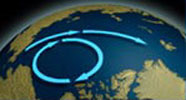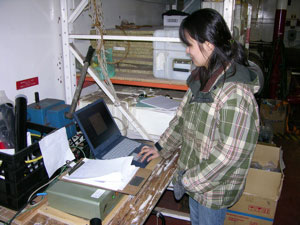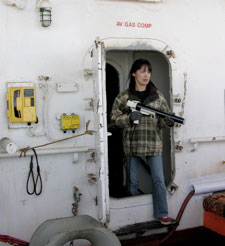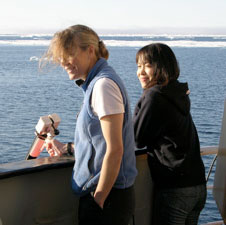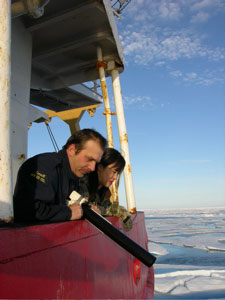Luc RainvilleAugust 25, 2007
The CTD rosette is a fantastic tool: you can get both the physical properties from the different sensors and several water samples to be analyzed. However, it does take quite a bit of time to do a CTD cast. Since we all want more data, more profiles more closely spaced, yet always have limited time, having the ability to measure the water properties without stopping the ship is a great advantage. Motoyo Itoh, from the Japan Agency for Marine-Earth Science and Technology (JAMSTEC), is coordinating the Expendable CTD program, with contributions from IOS, WHOI, and JAMSTEC. A X-CTD is a small probe, recording Conductivity and Temperature as functions of Depth, that can be launched from the stern of the ship while we are moving forward to speed up to 20 kts (we never go that fast... Typical speeds of the Louis are more like 12 to 15 kts in open water. Between rosette stations or when time is too tight to allow a full geochemical cast, she can be seen on the stern of the boat loading the 'X-CTD gun'. The X-CTDs turned out to be a great tool in the last day, as we had to leave Station A early (a site in the middle of the Canada Basin that has been occupied several times in the last few years) and head south to meet a large barge off Tuktoyaktuk, near the Mackenzie River delta, for refueling. The barge came from Vancouver and is bringing fuel to the high Canadian Arctic. We picked up 1,000,000 liters, enough to allow the Louis S. St-Laurent to stay in the Arctic for another month and drive back to Halifax. That's a lot of diesel! After that stop at the gas station, we are heading back to finish sampling at Station A - dropping several X-CTDs along the way. All these extra temperature and salinity profiles give us a clearer picture of the spatial and temporal structure - and variability - of the Arctic Ocean. That makes the physical oceanographers very happy. Unfortunately, I can't really see how the whole Expendable Water Bottle concept will ever work for Geochemistry...
Last updated: October 7, 2019 | |||||||||||||||||||||||
Copyright ©2007 Woods Hole Oceanographic Institution, All Rights Reserved, Privacy Policy. | |||||||||||||||||||||||
